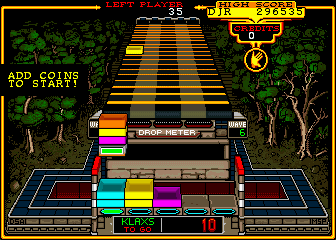This is a fun blog post with tips on using gamification to teach portfolio management principles (PPM). Portfolio management is not rocket science, but quickly conveying key concepts to people not familiar with project and portfolio management disciplines can be difficult. I learned this the hard way recently through my participation at two business competitions in Seattle. As I was working to come up with a simple message to explain portfolio management, I was reminded of a game I used to play in high school called Klax that actually contained many portfolio management principles. Klax is similar to many other puzzle games requiring players to connect multiple objects together of the same color. The basic game play involves colored tiles coming down a conveyor belt and the player needs to catch the tiles before they fall off and successfully drop them into a holding container (5 tiles by 5 tiles big) where points are scored by lining up at least three tiles in a row of the same color. The player can hold up to 5 tiles in order to better plan when and how to drop colored tiles into the bin. When colored tiles are lined up, points are scored and the tiles disappearing clearing up more space to drop more tiles. A vertical stack of three tiles scores the least amount of points, horizontal connections score more, and diagonal connections score even more. Skilled players can connect 4 and 5 tiles together to score more points and lining up tiles to form an “X” scores a massive bonus. The game becomes more and more challenging as the number of colored tiles increases and come faster down the conveyor belt. The game ends when a player has missed too many falling tiles or fills the container bin (demo).
Connection to PPM
As you can probably guess by now, such a simple game has some interesting correlations to help teach portfolio management principles. Each tile could represent a project proposal and aligning three or more proposals of the same type (color) to organizational goals or strategies drives greater value to the organization. The holding bin itself could represent organizational resource capacity to complete project work. Each vertical section of the holding bin could represent a different business unit or customer. Some projects (vertical stacks) focus only on a single customer or business unit, whereas other projects (horizontal and diagonal connections) are developed for multiple business units. Clearly, these sets of projects are harder to complete when multiple stakeholders are involved and represent higher risk to the portfolio. Vertical stacks of 3 tiles are the easiest to complete but score the lowest amount of points. Higher scores are generated by lining up 4 and 5 tiles together, which requires more skill and planning to make those connections. Players need forethought of when and how to place the tiles in order to generate maximum points. Certain levels also have certain goals that need to be achieved before the player can advance to the next level. For example, the player may need to complete five diagonals before the level is over. Creating vertical and horizontal stacks may still earn points and may be needed to clear space in the bin but does not directly achieve the required goal.
Portfolio Management Principles
Here are a few of the portfolio management principles that are easily displayed through the game:
1) Governance: the paddle that catches the tiles could represent a governance board that needs to decide which projects to do and when to do them. If too much work is proposed (on the conveyor belt), the governance board loses control, and chaos ensues.
2) Value maximization: a governance board should not only focus on getting work done, but ensure that the right work gets done at the right time to generate greater value. In the game, a vertical stack of three tiles helps clear the board and generates a few points, but nowhere near the value of larger horizontal and diagonal stacks.
3) Organizational goals: just as the game has a goal to be achieved before a player can advance to the next level, so organizations have their own goals and it is important to realize that not all projects support the goals of the organization. Appropriate portfolio planning is needed to achieve organizational goals.
4) Portfolio Risk: larger horizontal and diagonal stacks are harder to achieve and could represent organizational risk. Trying to get too much work done at once (setting up multiple diagonals or horizontals) jeopardizes the entire organization and could result in nothing truly getting done unless adequate attention is paid to managing the portfolio risk.
5) Pipeline management: the conveyor belt represents the current pipeline of project proposals and the speed at which the tiles come down the conveyor belt is a significant factor for determining the difficulty level of the game. Likewise, ensuring that there is a steady flow of projects that are dispatched appropriately is a success factor for portfolio management.
Try out the game and let me know what you think and how well it applies to portfolio management principles. A newer version of the game can be found here, but is only available for Apple products.

